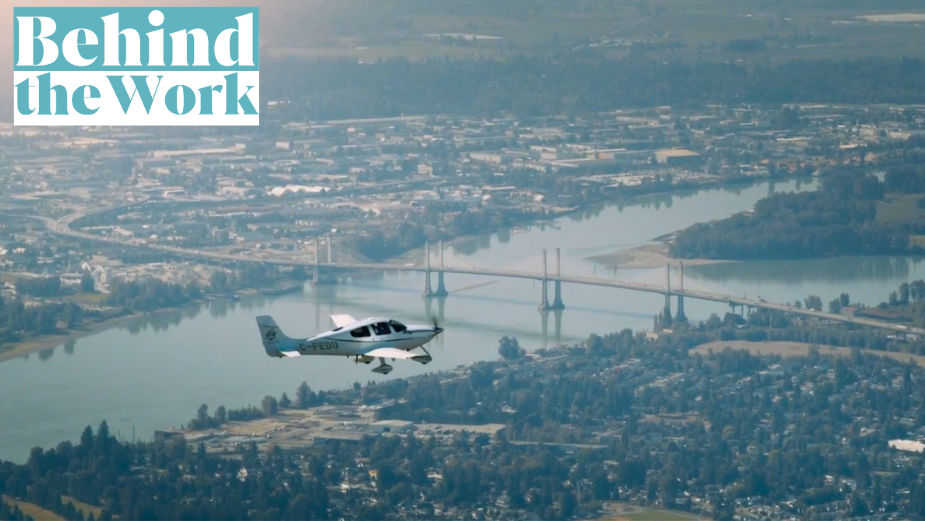
Inside Sean McBride and Hope Air’s Epic Journey “Into Darkness, and Back to Light”

It’s easy to understand the appeal of living amidst nature. Particularly in the more rural regions of Canada, there’s scarcely anywhere in the world that can compare to the crisp air, the fresh water, and the feeling of open freedom that comes with a sense of perfect isolation.
But there are hazards, too. When your life is lived at the whims of nature, there are potential risks that come along with the beauty. Harsh snowfalls, flooding, and wildfires can all contrive to bring a different, darker meaning to the idea of isolation. And for those people who need access to medical help, that can create dangerous - even life-threatening - situations.
Thankfully, that’s also why the work of Hope Air is so vital. For years, the charity has offered free travel and accommodations for Canadians in financial need who must access medical care far from home. And in order to tell that story in as moving and human a way as possible, they turned to Someplace Nice director Sean McBride.
The result is a powerful and awe-inspiring piece of film. To go behind the scenes and discover how it all came together, LBB caught up with Sean…
LBB> Sean, congrats on such a cinematic piece of work. What was your initial vision heading into the project, and how closely does it align with the finished film?
Sean> Thank you! I am very happy with how the film came together. I was looking to expand on my work in documentary and write a story with an emotional core that emerges from the fabric of humanity. I also wanted to add an epic element, and planes flying through mountains felt like the ideal combination.
I approached Hope Air with this concept in mind and we worked together to find a balance between narrative and messaging. What emerged was an epic journey through nature into darkness and back to light.
LBB> It's such a storytelling-focused piece of communication. Why does that approach work so well for the brand in this instance?
Sean> To understand what Hope Air does you really have to see how it works and who it works for. Interviews with their pilots and current and former patients revealed many interesting human perspectives and story notes. In consultation with Hope Air Chief Development Officer, Jon Collins, we determined it was best to focus on potential users who might not know that the service exists or what it does.
Insight also came from discussions with creative director Nicole Ellerton. A draw for people living in small towns is that it means that they get to live closer to nature, but that shouldn’t equate to less access to medical care when they’re not able to travel long distances to receive vital medical treatment. Knowing this, the plane becomes a kind of mythic character that helps Taylor surmount this barrier presented by the remoteness of extreme nature that she surrounds herself with.
I included details from the interviews in the film, such as how people learn about the service through their family doctor, how the service remains present throughout the entire treatment cycle, and how the plane’s cabin becomes a kind of solace amid the stress of dealing with serious medical treatments. Cinematographer Devin Karringten literally immersed himself in this project and crafted a beautiful visual story to compliment the emotional elements of the story. I’m very grateful for that collaboration which included his personal set of rehoused anamorphic lenses!
LBB> How did you get the shots of the plane mid-flight?
Sean> After much research I was given the number for Rob “Scratch” Mitchell. “Scratch” is the call sign he carries forward from an illustrious career as Colonel, RCAF (ret), CF18 fighter pilot, and a Commander of the Snowbirds (he is also a seasoned director himself). Once he learned about the story we were capturing for Hope Air, he offered to take on the coordination of the aerial shoot and fly the hero plane along with Hope Air Pilot Valery Milner. Scratch coordinated the entire operation including collaborating with a local commercial pilot to fly the camera ship. His detailed process helped everyone become comfortable with the close air to air formations that are outside of standard procedure for most private or commercial pilots.
A stabilised camera pod like a Shotover is the ideal platform for filming of this kind, but was out of reach for the budget. Instead, First AC Christian Eggenberger and I built a camera system to be stable yet nimble enough to film from various positions inside the jump plane’s rear cabin. We used a compact gimbal with a Red Komodo and Leica prime lens to achieve high quality images, and let us effectively move around in the plane’s tight cabin.
Scratch’s pilot skills cannot be overstated. Once we were aloft with the side door open and travelling through stunning views of the mountains along our predetermined flight path, I asked over the intercom where Scratch and Valery were as I couldn’t see from my strapped in position in the plane. My pilot, Chuck, slightly turned his head and pointed his thumb out the door and laughed, “Heh, they’re right there.” I strained to look just around the door frame and there was the hero aircraft, flying in perfect formation at what seemed like 50 feet away. We were able to capture beautiful images of the plane flying within an urban setting as well, which was essential to the story. I am just in awe of what we were able to achieve with a small crew who were so dedicated to the project and the cause.
Above: A selection of behind-the-scenes images taken from production.
LBB> Can you tell us anything about the casting process, and how did you know when you'd found the right people?
Sean> Early on I knew I wanted to work with actors rather than real people, as the subject matter was quite personal. Creatively, there was an opportunity to dramatise the experience, creating the opportunity to craft some beautiful performances yet have it still feel authentic. I could ask actors to access and deliver the emotions that go with this experience, instead of asking actual patients to relive some aspects that would be personal to them.
We looked for actors that knew about living in small towns so that their experiences could provide the foundation for their character and ultimately their performance. During call backs, we had our actors do a scene in which they are personally coming to terms with a challenging diagnosis, amid all of the struggles of daily life that likely would make seeking treatment impossible. Megan Toner, who plays Taylor, had interesting insights into the character which we referred back to during filming. We were lucky to find Megan as we were asking for multiple days and some shooting in the interior of British Columbia, which she was more than happy to be a part of.
LBB> There are some truly beautiful locations in the film. How did the scouting process work, and what were you initially looking for?
Sean> The terrain in this story is a character in itself. It is at once beautiful and natural, but also presents a barrier to accessing medical services. The mountains, rivers, lakes, and trees of BC dramatically portray these elements beautifully. The producing team, Kyle Hollett and Kita Nahanni of The Herd Films have access to a house in the interior of BC, and have a lot of experience filming there. We were able to find a lot of locations through their networks which gave us unprecedented access to some beautiful and authentic locations. The aviation community in BC generously collaborated with our project, letting us film in a hangar and ramp area at West Kootenay Regional Airport. For the hospital scenes we used a college with a nursing program, which was a genius move on the producer’s part.
LBB> And did the terrain provide any specific challenges?
Sean> Thankfully all of our locations were accessible by road so we didn't have to go into the interior to find beautiful frames. It was late summer and the heat and dryness posed the threat of a forest fire igniting nearby at any time and there were many a few kilometres from us. Aerial fire fighting operations were happening out of West Kootenay airport while we were filming so the realities of this were ever present. We kept our eye on local reports, but one morning we woke up to find the town swathed in thick forest fire smoke. The source was near, but it felt like it was around the corner. We had finished filming in Castlegar, but hastened our departure as a result.
The drive to Vancouver was 7.5 hrs with crew and gear in two vehicles and at one point we passed a fire raging on a mountain beside the road. Coming from Ontario I had never been this close to the realities of wildfires which have left an indelible impression on me. My camera and travel bags still smell of the smoke from BC.
LBB> Aside from that, what was the biggest challenge you encountered and how did you overcome it?
Sean> Part of planning this project centred around using a small crew of multitalented individuals who could wear many hats. In some cases, we had to be nimble and come up with simple solutions that would still achieve a level of visual sophistication. DP Devin, Producer Kyle and I set up a mini studio in the hangar in Castlegar to film the interior plane scenes. This is true filmmaking, and if you ask Kyle and Devin, they’ll say it's their favourite kind. I have to agree.
LBB> Finally, did you learn anything yourself about Hope Air's work as a result of this project - or did it give you a fresh perspective on life in rural communities?
Sean> Shooting in the mountainous interior of BC, you get the sense that towns like these are like oases among extreme geography; somewhat isolated and at the mercy of nature and weather. Imagine massive snowfalls that could close entire highways and you understand how vital Hope Air is. Sometimes you need to drive two hours to access the nearest airport, which is represented in the opening shot of the spot. This is people helping people which is more evident in small towns. I feel very fortunate to be able to encapsulate this into the spot, and I am excited for its release.













